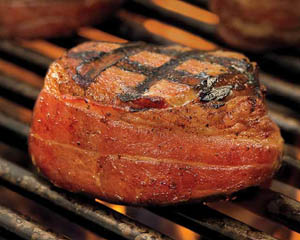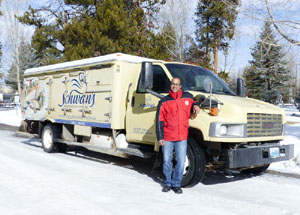Schwan's
Sublette County History Contest Answer: Serious Sawbuck was a slang name for the company “Sears & Roebuck” as appeared in the May 3, 1906 Cora Sentinel newspaper for an ad for The Cora Store.
The answer to this question could be found by doing a word phrase search of the online Wyoming historic newspaper archives, a service of the Wyoming Public Library, at http://newspapers.wyo.gov/. This newspaper archive is growing and currently has 340 early Wyoming newspapers dating from 1849 to 1922. In the early 1900s local rural stores struggled even more when faced with new competition from two large companies that expanded their storefront retail businesses and set up mail order components. The two companies printed large “wish book” catalogs filled with a world of interesting and enticing products at low prices to encourage people to buy from them through the mail rather than shop at their local stores. People loved pouring through the thick catalogs with page after page of items they could dream about and wish for, if they only had the money. The two companies were Montgomery Ward and Sears & Roebuck. It was possible to get most anything through the catalogs, even kit homes to build a complete house. There still are several Sears & Roebuck kit homes standing in Sublette County today, the supplies brought up from the railroad in Opal to the Upper Green. Frank and Jessie Fear settled on South Piney Creek in 1889 and in 1914 bought a Sears and Roebuck mail order kit house which was hauled from Opal in 65 wagon loads and cost $2250. The house still stands on the old place. The successful mail order business by Sears and Roebuck and Montgomery Ward put such a dent in the business of local merchants it gave rise to all out war campaigns across the country against the two large companies. Some accounts relate that shopkeepers lit bonfires in town squares and offered bounties for every new catalog turned in for fuel. Some merchants offered prizes and free admission to movies for every catalog turned in for trade. Derogatory slang came into common use coining names of “Monkey Wards,” “Shears and Sawbuck,” “Sheers and Sawbucks,” “Rears and Soreback,” and “Sears and Sawbuck” for the companies. The May 1906 Cora Sentinel newspaper (Cora, Wyoming), the very first edition of that paper, published a large ad on the front page for The Cora Store in which he used the term. In it, proprietor J.H. Bemis puts out a plea to customers to shop locally saying the store carries a full and complete line of Dry Goods, Clothing, Hats and Caps, Boots and Shoes, Groceries, Hardware and Ammunition, Ladies’ Ready to wear, Waists and Shirts…” and more. In the ad, Bemis says, “ “MONKEY WARD” or “SERIOUS SAWBUCK” never did or never will throw a $ in your way. You know it, don’t you? Come in and see our new goods, anyway. It will not cost you a “red” and if you don’t buy we will not quarrel with you.” Yours for Business = J.H. Bemis= There are only two known surviving editions of the Cora Sentinel newspaper. The May 3, 1906 edition is available online on the Wyoming Newspaper project website: http://newspapers.wyo.gov/ The newspaper apparently only ran for a couple of years and copies of the weekly paper did not survive. A second Cora Sentinel from October 25, 1906 turned up several years ago and a copy is available to read at the Sommers Homestead Living History Museum through the Sublette County Historical Society. The historic old newspapers, with their stories and the paid advertising, give first-hand accounts of the daily lives of people who lived during those times and what they were dealing with and living through. Information that can be found includes local and world news of the time, local business ads, births, deaths and obituaries, social and sporting events, political happenings, land transactions, movements of people and more. Online copies for the Pinedale Roundup, Big Piney Examiner, Cora Sentinal newspapers for the Upper Green River Valley prior to 1922 are available for free viewing. Other papers are available for the late 1800s and early 1900s for surrounding towns in western Wyoming and 340 titles across the state. They make for fascinating reading and you can find yourself spending hours reading the old stories and what life was like back then. The clues for this week attempted to show the number of enterprising people in the early days who took on the financial risks and challenges to start stores as business ventures to provide goods and services to the remote settlers and ranchers in the Upper Green River Valley. The people who lived here at that time faced huge challenges to get supplies the long distances from stores up into the valley. Poor roads, no bridges over rivers, travel by horse and mule drawn wagons, nine months of winter, long distances between settlements, accidents, and more had to be overcome to survive and make a living. Ultimately, it wasn't just competition from mail order business that make life difficult for local merchants. The advent of the automobile, urban growth and the chain store also contributed to further undermine the small local retailer. Businesses were able to help themselves better compete by taking advantage of the telephone, improved road and transportation networks, and quicker delivery turn-around, and local good customer service. Small rural businesses have always been challenged to give their customers what they want at an affordable price to compete with bigger, more distant companies that are able to offer more product variety and lower prices because of their larger volume buying power and bigger customer bases. While
the commerce war in earlier years was battling mail order companies,
today similar “Buy Local” urgings and complaints
can still be heard by local brick and mortar store merchants who
find it difficult to compete with the prices and large variety
of products offered by far away companies that make it cheap and
easy to shop for a vast array of items on the internet. Throughout
time, businesses have been both helped and thwarted by advances
in technology and improvements in transportation networks and communication
systems. Week
5 Clues 2. "Sawbuck" is also a slang term for a U.S. $10 bill, derived from the similarity between the shape of a sawbuck device and the Roman numeral X (10), which formerly appeared on $10 bills. (Image source: https://en.wikipedia.org/wiki/United_States_ten-dollar_bill#/media/File:US-$10-LT-1863-Fr-95b.jpg) 3.
Settlement of the Upper Green River Valley of Wyoming happened
relatively
late in American history compared to other areas of the
country, in the late 1800s. Despite the fact that thousands of
emigrants passed through the region over the Sublette Cut-off
or the more northerly
Lander Cut-off, settlement of what would become the southern
part of Sublette County did not begin until the late 1870s. 9 The Daniel Post Office was established in 1900 with Thomas P.
Daniel the first postmaster. Daniel, for whom the town was named,
operated the post office at his store. After 1914, the store
was later operated by E. D. Key. 15. The tough life of the early days of rural settlement caused people to be extremely self-reliant and create tight-knit communities that relied heavily on each other for support to make their livings. Modes of communication including mail delivery, newspapers, telegraph, telephone and road networks were extremely important to early settlers. Digital copies of many early editions of Wyoming newspapers prior to 1924 are available to read online at the Wyoming Newspapers project website, http://newspapers.wyo.gov/. 16.
The Sublette County Libraries in Pinedale and Big Piney, and
The Cowboy Shop and Office Outlet stores in Pinedale carry books
written by local authors that have information and stories about
early settlement history of the Upper Green River Valley. Local
author books with local history are also available from the
Green River Valley Museum in Big
Piney, the Museum of the Mountain Man in Pinedale, and the Sommers
Homestead Living History Museum (all open summer months). _________________________________________________________
Official
Rules: |
SPONSORS
____________ ____________ PRIZES:
WEEK
1 History Question:S WEEK
2 History Question:S
WEEK
3 History Question:S Winner: Bonnie
Whitley,
Boulder
WEEK
4 History Question:S WEEK
5 History Question & Clues: Week
6 Questions: Winner: Lisa Williams, Cora, Wyoming KPIN
Radio ad for Week 6 Meet Jean-Francois Lefebvre, your friendly Pinedale area delivery driver for Schwan's. Orders are placed online via www.schwans.com. Jean-Francois comes up to Pinedale from the Rock Springs Schwan's distribution center several days a week to deliver orders. He can be reached at 307-360-FOOD (3663). |
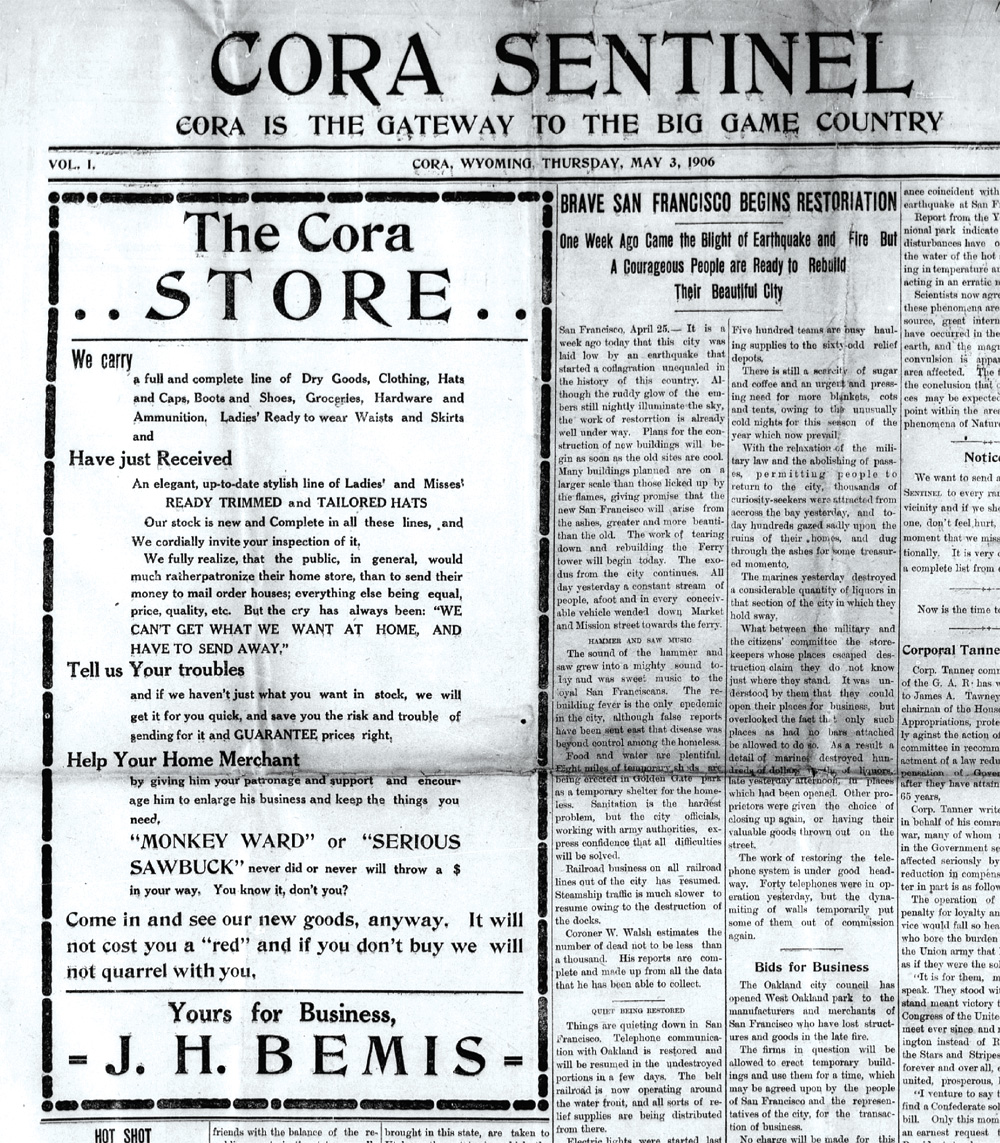
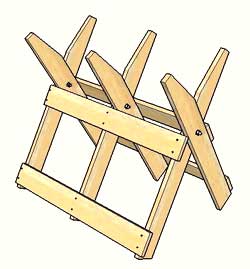 1.
A sawbuck is a device for holding wood so that it may be cut
into pieces.it consists of an "X" form at each
end which are joined by cross bars below the intersections
of the X's.
The stock to be cut is placed in the V's formed above the intersections
of the X's. (Image source: https://en.wikipedia.org/wiki/File:Sawbuck_diagram.jpg)
1.
A sawbuck is a device for holding wood so that it may be cut
into pieces.it consists of an "X" form at each
end which are joined by cross bars below the intersections
of the X's.
The stock to be cut is placed in the V's formed above the intersections
of the X's. (Image source: https://en.wikipedia.org/wiki/File:Sawbuck_diagram.jpg)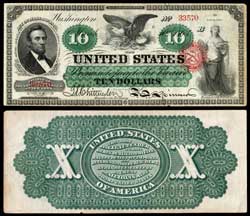 Part
of
the reason was because choicer lands were more easily obtained
elsewhere
and only the very hardy chose the remote arid lands that were
very distant from major transportation corridors. Cattlemen discovered
the area first and learned that their stock could graze year-round
on the prairie grasses. The land became settled by rugged individuals
who worked hard to carve out livelihoods from the wilderness.
Part
of
the reason was because choicer lands were more easily obtained
elsewhere
and only the very hardy chose the remote arid lands that were
very distant from major transportation corridors. Cattlemen discovered
the area first and learned that their stock could graze year-round
on the prairie grasses. The land became settled by rugged individuals
who worked hard to carve out livelihoods from the wilderness.




